- Submissions

Full Text
Aspects in Mining & Mineral Science
Growth of SiC Whiskers in Beryl by a Natural Supercritical VLS Process
Rainer Thomas*
Germany
*Corresponding author:Rainer Thomas, Im Waldwinkel 8 D-14662 Friesack, Germany
Submission: June 07, 2023; Published: June 16, 2023

ISSN 2578-0255Volume11 Issue4
Abstract
This short paper shows the unusual occurrence of SiC whiskers grown in beryl by a supercritical VLS (vapor-liquid-solid) process. The beryl sample is from a small beryl-quartz veinlet related to the Variscan tin deposit Ehrenfriedersdorf in the Saxon Erzgebirge. The SiC or moissanite, often twisted along the c-axis, is of the hexagonal 6H-SiC polytype and generally forms needle- or whisker-like crystals parallel to the c-axis of beryl. Up to now, the growth mechanism is not precisely known, especially for the nature of the VLS liquid catalyst. Nanodiamonds in the supercritical fluid take over the role of the growth trigger. The maximum temperature of the beryl and moissanite crystallization is 720 °C.
Keywords:SiC whisker; Beryl; Supercritical fluids; Nanodiamonds as the catalyst; Raman spectroscopy; Ehrenfriedersdorf tin deposit
Introduction
By careful microscopic and Raman spectroscopic looking through old samples from rare beryl-quartz veinlets related to the Variscan tin deposit Ehrenfriedersdorf (Sauberg mine) in the German Erzgebirge, unexpected SiC needles and whiskers in beryl were found. It will discuss shortly the origin of this unexpected paragenesis. To understand the related tin mineralization, the paper from Schröcke [1] & Hösel [2] are recommended, which comprehensively describes this famous deposit. However, a description of the small beryl veins is missing. Only Kumann & Leeder [3] discuss this very shortly in their contribution and show such veins’ appearance. However, they have not studied the beryl. This short contribution concisely describes the unusual beryl-moissanite paragenesis and the method used for the unequivocal proof. The VLS process for the SiC whisker growth discussed in this paper stands V for vapor feed, L for liquid catalyst, and S for solid SiC whisker growth (see further below).
Sample Material & Methods
The sample is from a 6cm thick beryl-quartz veinlet from the Ehrenfriedersdorf Sauberg mine (Prinzler Liegendtrum, sample BAF F64-18) composed of about 28% beryl and 72 % quartz. Figure 1 shows a piece from this beryl-quartz veinlet. The beryl is transparent and pale green and contains many secondary fluid inclusions. Primary melt inclusions (tH ~720 °C, see [4] are rare. Besides numerous small (10-20μm) mineral inclusion like beryl-II, zircon, OH-rich topaz, sphalerite, and arsenopyrite, often spherical or elliptical, many needles and whisker-like black crystals of SiC (moissanite) are present. Larger beryl crystals show indications of tectonic demand perpendicular to the c-axis resulting in a dispersal of large SiC needles. Double-polished thick sections with a thickness of 500μm for the study were used. All microscopic and Raman spectroscopic studies are performed with a petrographic polarization microscope with a rotating stage coupled with the RamMics M532 Raman spectrometer working in the spectral range of 0-4000cm-1 using a 50mW single-mode 532nm laser. The Olympus long-distance LMPLN100x as a 100x objective lens was used for Raman spectroscopic routine measurements. Details are given in Thomas [5].
Figure 1:Detail of the studied quartz-beryl sample from the Sauberg mine near Ehrenfriedersdorf: Brl-green beryl, Mlb-molybdenite, Qtz–quartz.
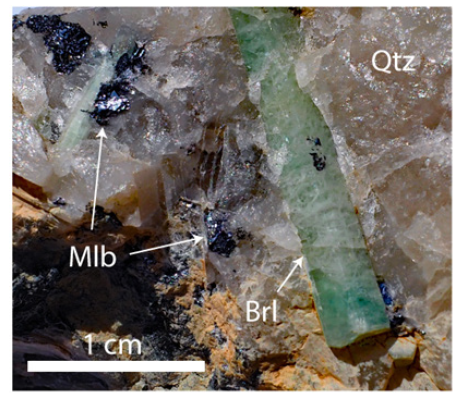
Result
The beryl of the studied samples contains many black whiskerlike needles of moissanite arranged generally parallel to the c-axis of the beryl. About 15000 to 35000 such SiC crystals per 1cm3 were counted. Figure 2 shows a SiC whisker in the center of a beryl crystal. Up to now, the most extended needle is 1540μm long. Depending on the cutting slope, the cross-section is spherical to elliptical. The whiskers are often twisted along the c-axis, and Raman spectroscopic studies show this SiC is of the hexagonal polytype 6H-SiC [6,7]. Figure 3 presents several such SiC whiskers parallel to the c-axis of a beryl crystal (same position, however different depths). Table 1 compares the Raman measurements on natural SiC (whiskers and needles) in beryl and technical SiC. Figure 4 depicts a typical Raman spectrum of a SiC whisker. The linewidths of the main Raman band at about 770cm-1 is 25cm-1, and that is for the natural SiC 4 fold more extensive than the synthetic/ technical one. Figure 5a shows the start point of the SiC whisker growth in Figure 2 by the VLS process. The Raman spectrum in Figure 5b represents the nanodiamonds (nD) at the basis of the supercritical VLS catalyst ball.
Figure 2:An about 600μm long moissanite (SiC) whisker in the center of a beryl (Brl) crystal (crossed Nicols). Qtz– quartz.

Figure 3:Several such SiC whiskers parallel to the c-axis of a beryl crystal (Brl) from the Ehrenfriedersdorf Sauberg mine. Figures a) and b) show the same position in different depths.
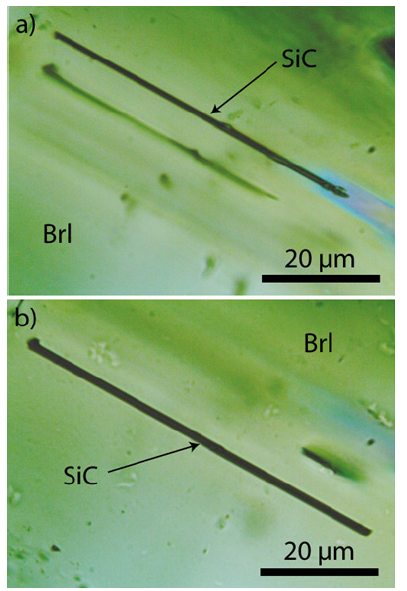
Table 1: Experimental Raman-active vibrational modes of the SiC polytype 6H-SiC in beryl from Ehrenfriedersdorf, Erzgebirge, Germany, and a synthetic/technical reference. n-number of studied SiC crystals; vibration modes according to [6,7]: AA-Axial Acoustic Mode, LA-Longitudinal Acoustic Mode, LO-Longitudinal Optic Mode, PA-Planar Acoustic Mode, PO-Planar Optic Mode, TA-Transversal Acoustic Mode, TO-Transversal Optic Mode. Intensity: vw-very weak, w-weak, m-medium, s-strong, vs-very strong; FWHM-line widths(full width at half maximum).

Figure 4:Typical Raman spectrum of a SiC whisker in the Ehrenfriedersdorf tin deposit beryl.

Figure 5a:Several such SiC whiskers parallel to the c-axis of a beryl crystal (Brl) from the Ehrenfriedersdorf Sauberg mine. Figures a) and b) show the same position in different depths.
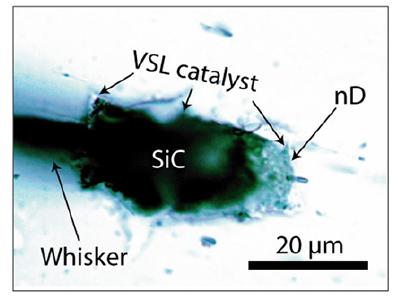
Figure 5b:Raman nanodiamond (nD) spectrum in the supercritical VLS catalyst ball. Brl–beryl.
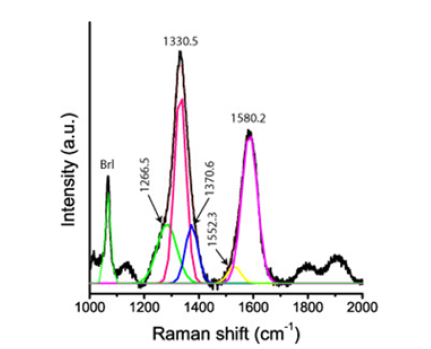
McMahon et al. [8] give an idea about the growth mechanism of silicon carbide whiskers. The composition and structure of the VLS liquid catalyst (Figure 5a) is the task for further sophisticated studies. Noteworthy is that this elliptical catalyst ball is composed of SiC, graphitic carbon, and nanodiamonds. The composition of the liquid phase of the catalyst is unclear – maybe a metastable Bebearing supercritical melt droplet on the growing beryl substrate [9]. Beryl, SiC, and nanodiamonds in the catalyst ball are noteworthy. The vapor phase, methane, is often seen as a supercritical highpressure phase inclusion in beryl (Figure 6). The vapor phase consists exclusively of methane (CH4), and cristobalite (Crs) forms the solid phase of both inclusions. A necking-off process creates both inclusions (Roedder [10], p. 59). Cristobalite in the methane inclusion is stable under laser light and is metastable in the waterbearing fluid inclusion (forming quartz). With the used Raman spectrometer, in no case hydrogen using the pure rotational lines S0 (354.8cm-1), S1 (587.4cm-1), S2 (815.0cm-1), and S3 (1034.9cm- 1) could be determined - See [9]. The cristobalite was primarily water-rich stishovite or coesite, giving the supercritical fluid a minimum pressure of 7GPa. Figure 7 shows a Raman spectrum of the cristobalite in the CH4-rich inclusion of Figure 6. Conspicuous are the strong nanodiamond band at 1328cm-1 and the strong carbon band at 1590cm-1. The catalyst ball was partially distorted or destroyed during the further growth of beryl.
Figure 6:Two supercritical inclusions in beryl (Brl). CH4-methane, Fl–aqueous liquid phase. Cristobalite (Crs) in both inclusions gives in the Raman spectrum strong lines at 112.6, 229.8, 418.6, and 1072.1cm-1, respectively.

Figure 7:Raman spectrum of cristobalite, nanodiamond, and carbon in the CH4-rich inclusion of Figure 6. The Raman bands at 109.8, 228, 414.3, 792, and 1070.5cm-1 correspond to cristobalite. The 1328.5 and 1590cm-1 bands correspond to nanodiamonds and carbon, respectively.
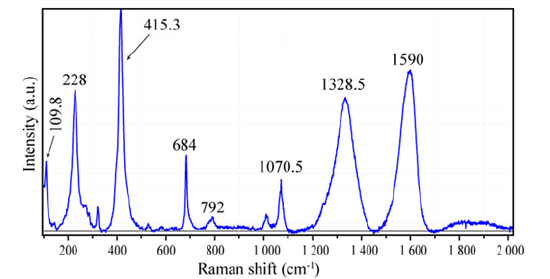
Discussion
The finding of SiC whiskers in beryl is astonishing because the crystallization of SiC whiskers generally happens at very high temperatures. In the given example, moissanite forms with beryl around 720 °C, which is very low in contrast to the growth of β-silicon carbide whiskers at about 1400 °C by the VLS process [11]. The low temperature corresponds to the idea presented by Schmidt et al. [12]. Also, the nanodiamond participation at such low temperatures is remarkable. Following Buchner et al. [13], nanodiamonds as a catalyst can play a crucial role in the growth of moissanite at significantly lower temperatures. The essential step is changing from the supercritical state to the critical/under critical condition.
Furthermore, the present study shows that the supercritical fluid is rich in nanodiamonds. Nearby all SiC whiskers contain nanodiamonds. A supercritical fluid or melt is responsible for the VLS process; further studies are necessary to illuminate this process in more detail. A concise description of the beryl-moissanitegraphite paragenesis related to the Variscan tin mineralization of the Erzgebirge, Germany, will be given in a forthcoming paper by the author.
Acknowledgment
The sample material was given by Prof. L. Baumann (1929- 2008) from the Mining Academy Freiberg in 1980 as reference material.
References
- Schröcke H (1954) On the paragenesis of tin ore deposits in the Erzgebirge. New J Mineral Dep 87(1): 33-109.
- Hosel G (1994) The tin ore deposit area of Ehrenfriedersdorf/Erzgebirge. Mining Monograph, State Office for Environment and Geology, Freiberg 1: 195.
- Kumann R, Leeder O (1994) On the relations between granite and ore in the Ehrenfriedersdorf tin deposit, Erzgebirge. Metallogeny of collisional Orogens. In: Seltmann R, Kämpf H, Möller P (Eds.), (1993) Proceedings of the IAGOD Erzgebirge Meeting, Geyer, Germany, pp. 166-173.
- Thomas R, Webster JD, Davidson P (2011) Be-daughter minerals in fluid and melt inclusions; implications for the enrichment of Be in granite-pegmatite systems. Contrib Mineral Petrol 161(3): 483-495.
- Thomas R, Davidson P, Rericha A, Recknagel U (2023) Ultrahigh-pressure mineral inclusions in a crustal granite: Evidence for a novel transcrustal transport mechanism. Geosciences 13(4): 94.
- Chikvaidze G, Mironova-Ulmane N, Plaude A, Sergeev O (2014) Investigation of silicon carbide polytypes by Raman spectroscopy. Latvian Journal of Physics and Technical Sciences 3: 51-57.
- El Mendiki Y, Orberger B, Chateigner D, Bardeau JF, Gascoin S, et al. (2020) Insight into the structural, elastic and electronic properties of a new orthorhombic 6O-SiC polytype. Scientific Reports 10: 7562.
- McMahon G, Carpenter GJC, Malis TF (1991) On the growth mechanism of silicon carbide whiskers. Journal of Materials Science 26: 5655-5663.
- Petrov DV, Matrosov II, Sedinkin DO, Zaripov AR (2018) Raman spectra of nitrogen, carbon dioxide, and hydrogen in a methane environment. Optics and Spectroscopy 124(1): 8-12.
- Roedder E (1984) Fluid inclusions. Reviews in mineralogy. In: Ribbe PH (Ed.), Mineralogical Society of America, 12: 644.
- Milewski JV, Gac FD, Petrovic JJ, Skaggs SR (1985) Growth of beta-silicon carbide whiskers by the VLS process. Journal of Materials Science 20: 1160-1166.
- Schmidt MW, Gao C, Golubkova A, Rohrbach A, Connolly JAD (2014) Natural moissanite (SiC) – a low temperature mineral formed from highly fractionated ultra-reducing COH-fluids. Progress in Earth and Planetary Science 1(27): 1-14.
- Buchner F, Kirschbaum T, Venerosy A, Girard H, Arnault JC, et al. (2022) Early dynamics of the emission of solvated electrons from nanodiamonds in water. Nanoscale 14: 17188-17195.
© 2023 Rainer Thomas. This is an open access article distributed under the terms of the Creative Commons Attribution License , which permits unrestricted use, distribution, and build upon your work non-commercially.
 a Creative Commons Attribution 4.0 International License. Based on a work at www.crimsonpublishers.com.
Best viewed in
a Creative Commons Attribution 4.0 International License. Based on a work at www.crimsonpublishers.com.
Best viewed in 







.jpg)






























 Editorial Board Registrations
Editorial Board Registrations Submit your Article
Submit your Article Refer a Friend
Refer a Friend Advertise With Us
Advertise With Us
.jpg)






.jpg)














.bmp)
.jpg)
.png)
.jpg)










.jpg)






.png)

.png)



.png)






